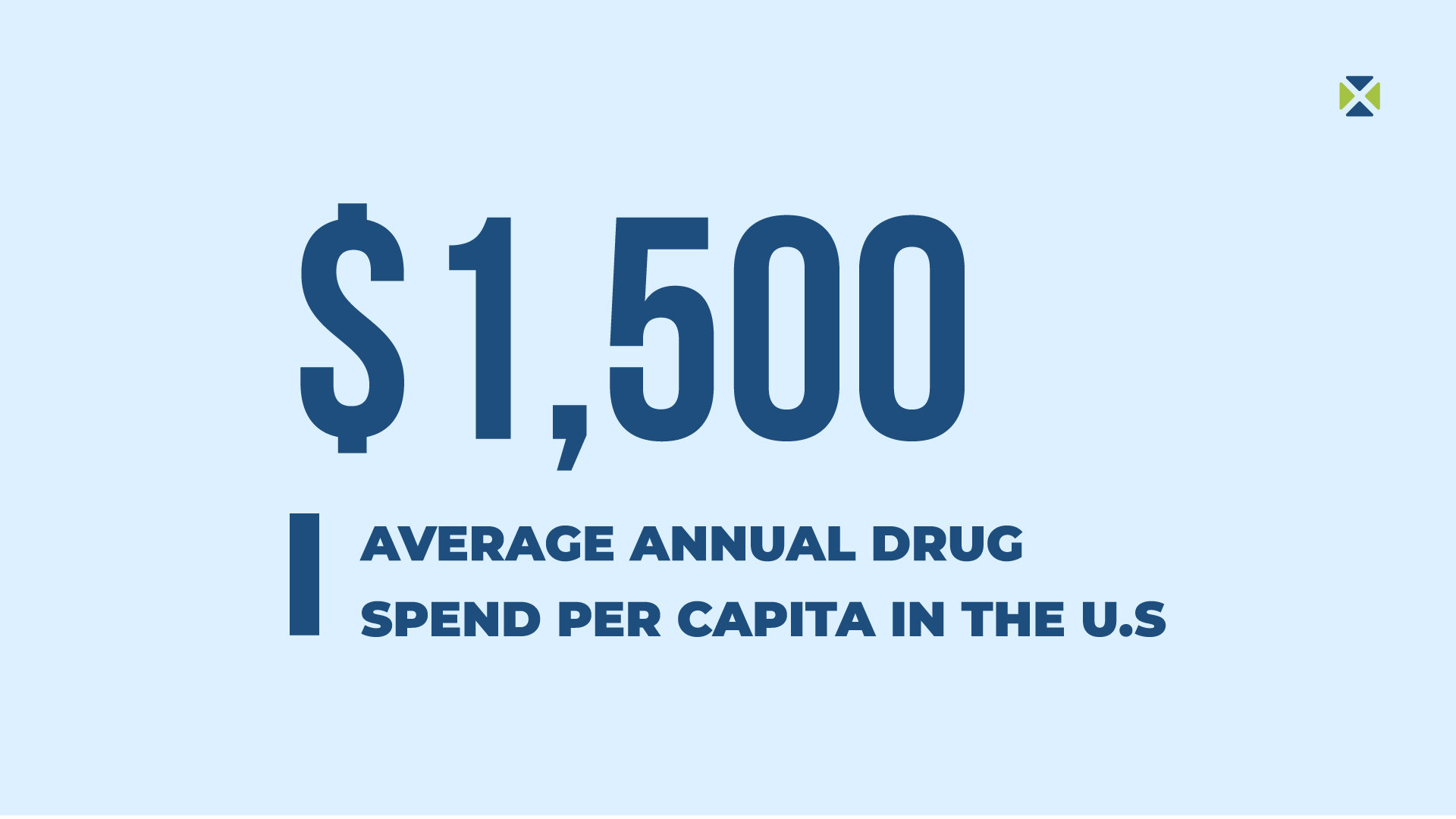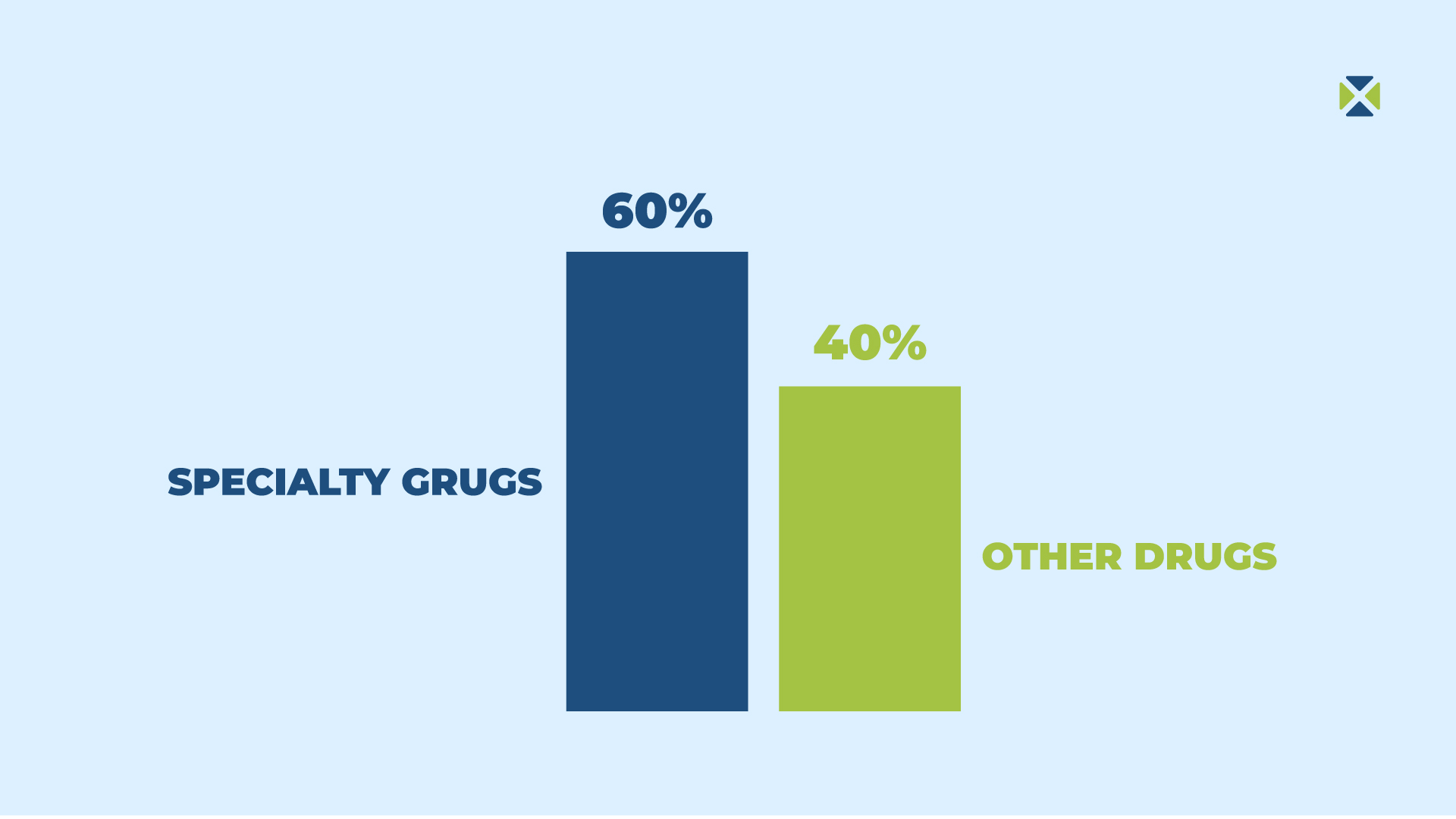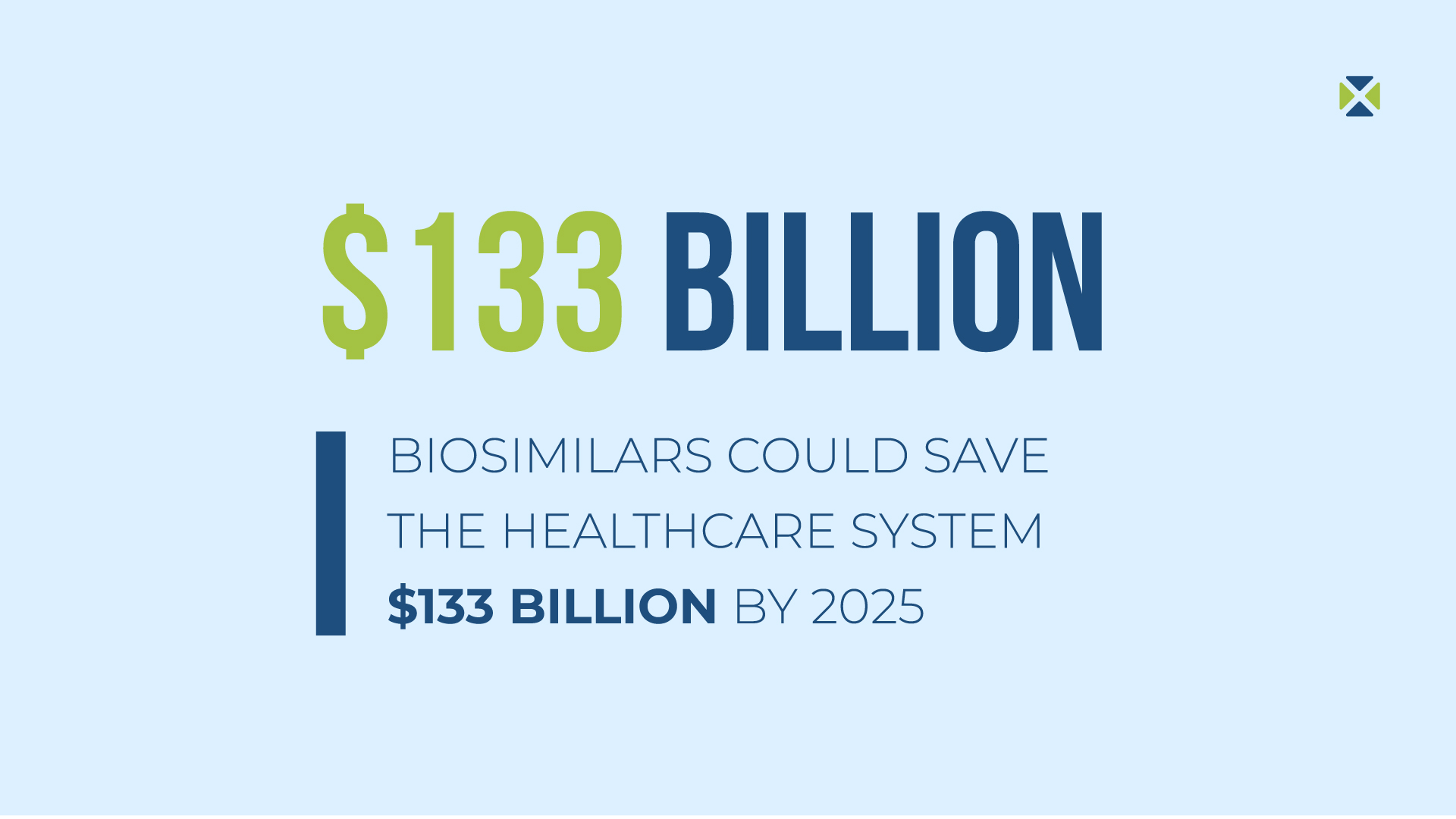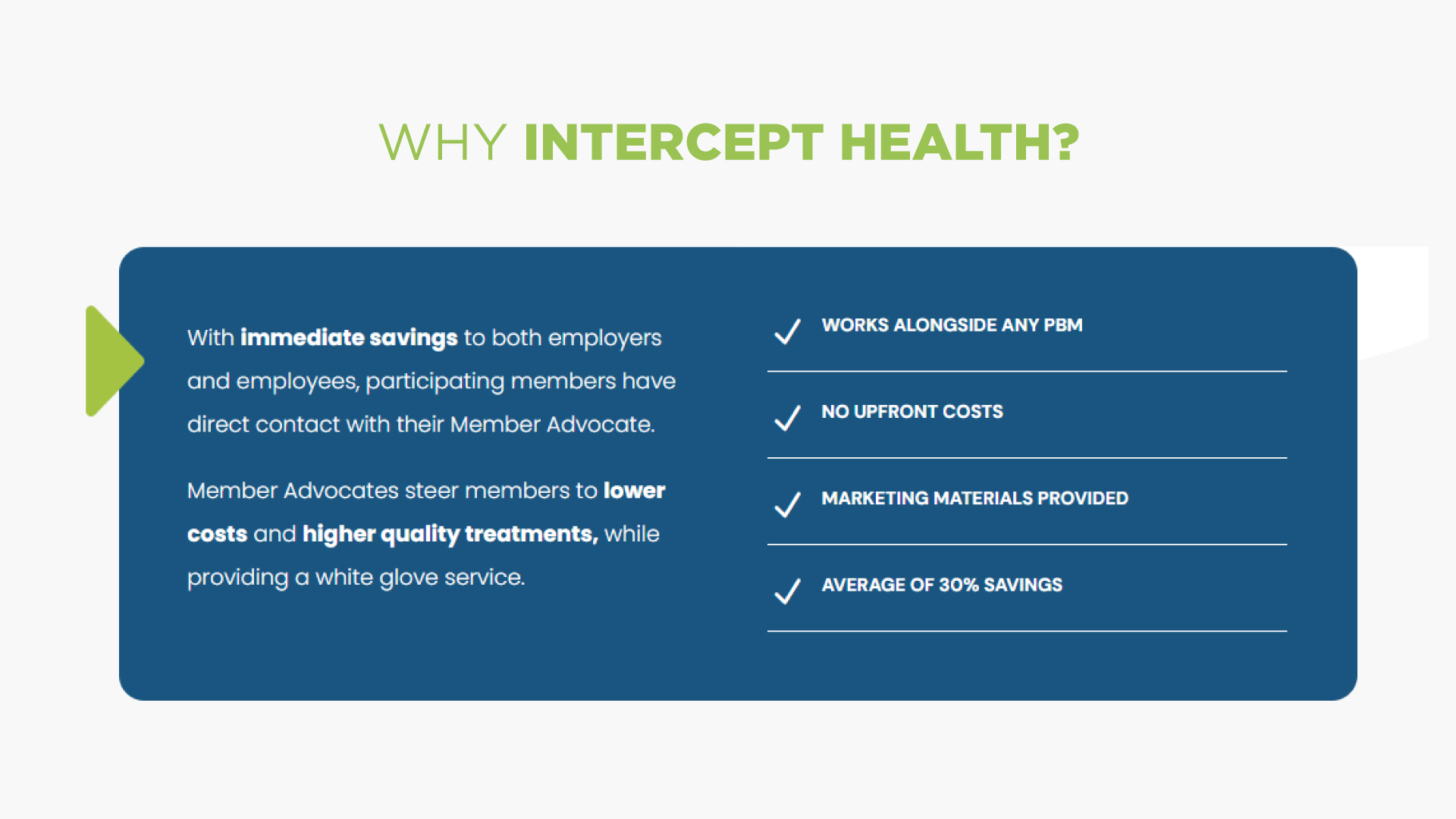Essential highlights: 2025 drug pricing predictions
- Drivers of rising drug costs in 2025: Inflation, supply chain issues, and specialty drug innovation continue to drive up prices.
- Specialty drugs, biosimilars, and legislative impact: Expect growth in specialty drugs, biosimilars, and pricing regulations.
- Employer challenges and solutions: Managing higher pharmacy costs while offering competitive benefits is key.
- Employee impact of rising drug costs: Without cost controls, out-of-pocket expenses will rise.
- Intercept Rx: The solution to managing drug costs: Intercept Rx’s Rx Optimization Program helps manage rising drug costs effectively.

What to expect in prescription drug pricing for 2025
Prescription drug prices have been climbing steadily over recent years, creating financial strain for both employers managing benefit costs and employees struggling to afford essential medications. With 2024 setting the stage for further increases, it’s more important than ever to anticipate what’s coming next.
In 2025, key trends such as the growing demand for specialty medications, pricing regulations, and innovations in biosimilars are expected to shape the market. Employers and employees will need proactive strategies to navigate these changes and control costs without sacrificing access to necessary treatments.
As a forward-thinking Pharmacy Benefit Solutions provider, Intercept Rx stays ahead of these trends by offering cost-management programs and innovative tools. This article explores the current landscape, future predictions, and actionable solutions to help employers and employees prepare for the road ahead.

1. Current state of prescription drug pricing
Why drug prices continue to climb
In 2024, prescription drug prices continued their upward trajectory, placing significant financial pressure on both employers and employees.
According to the Kaiser Family Foundation, the average annual drug spend per capita in the U.S. was approximately $1,500.¹ This high expenditure underscores a critical issue: controlling pharmacy benefit costs has become increasingly challenging in the face of rising prices.
Several key factors have driven the current pricing trends:
- Inflation: General inflationary pressures have contributed to increased production and distribution costs, ultimately leading to higher drug prices.
- Supply chain issues: Ongoing supply chain disruptions, from raw material shortages to delays in manufacturing and transportation, have further inflated costs.
- Innovation in specialty drugs: The growing demand for advanced specialty medications, particularly for chronic and rare diseases, has significantly impacted overall drug spending. Specialty drugs, which often come with a high price tag, now account for a larger share of total pharmacy costs.
These trends from 2024 set the stage for 2025, where further shifts in pricing and demand will likely continue. Employers and employees must prepare for these challenges by staying informed and adopting proactive cost-management strategies.
2. Predicted trends in 2025
As we move into 2025, several key trends are expected to shape the prescription drug market, influencing pricing and access. Employers and employees alike will need to navigate these shifts carefully, as rising demand for specialty medications, new pricing regulations, and technological innovations will drive significant changes in the pharmacy benefits landscape.

Specialty drugs: The dominant driver of costs
The demand for specialty drugs—those used to treat chronic and rare diseases—is projected to increase further.
These high-cost medications, which already account for a substantial portion of pharmacy spending, could represent 60% of total drug spending by 2025.² This shift highlights the importance of managing specialty drug costs effectively, as they pose a growing challenge for employers offering comprehensive pharmacy benefits.
Legislative pricing changes on the horizon
Legislative action at both the federal and state levels will continue to exert pressure on drug pricing:
- Federal programs: Government price negotiation programs, such as those introduced under the Inflation Reduction Act, aim to lower the cost of certain high-priced medications.
- State-level policies: Several states are expected to implement or expand policies focused on increasing transparency in drug pricing and capping costs for consumers. These efforts could lead to pricing adjustments across the market but may also introduce complexities for employers managing pharmacy benefits.

Biosimilars: Cost savings potential in 2025
With patents on popular biologic drugs expiring, the biosimilars market is set to expand rapidly. Biosimilars—lower-cost alternatives to biologics—offer significant savings potential.
According to a report by the RAND Corporation, biosimilars could save the healthcare system $133 billion by 2025.³ As the adoption of biosimilars grows, employers may benefit from lower pharmacy costs, provided they have the right strategies in place to encourage their use.
AI and Blockchain: The future of transparent pricing
Advancements in technology are expected to transform drug pricing models:
- AI-driven insights: Artificial intelligence (AI) can analyze vast amounts of data to provide real-time pricing insights, helping employers and pharmacy benefit managers (PBMs) negotiate better rates.
- Blockchain for transparency: Blockchain technology, known for its secure and transparent data-sharing capabilities, could be adopted to create more transparent pricing systems, reducing inefficiencies and ensuring fair pricing for all stakeholders.
These predicted trends underscore the importance of staying ahead in the pharmacy benefits landscape.
Employers who proactively prepare for these changes—by adopting advanced cost-management solutions and leveraging new technologies—will be better positioned to control costs while continuing to offer competitive benefits. For more insights on how competitive benefits can help attract and retain top talent, check out 9 Key Tips for Attracting and Retaining Top Talent in Today’s Competitive Job Market.

3. Implications for employers
The rising cost of prescription drugs presents significant challenges for employers, particularly those managing self-funded or level-funded pharmacy benefit plans. Higher pharmacy benefit costs can strain budgets, making it difficult to maintain financial balance while offering robust employee benefits.
Tackling rising pharmacy costs head-on
Employers face increasing pressure to cover the growing demand for specialty medications, which often carry high price tags. Without effective cost-containment strategies, these rising costs can erode profits and limit resources for other critical business investments.
Why competitive benefits are non-negotiable
In a competitive job market, offering comprehensive and competitive benefits is essential for attracting and retaining top talent.
Pharmacy benefits are a critical component of any benefits package and managing them effectively is key to standing out as an employer of choice. For more insights on how benefits can drive recruitment and retention, read Top Benefits Employees Want in 2025.
The Rx Optimization advantage for employers
To address these challenges, programs like Intercept Rx’s Rx Optimization Program provide actionable solutions. By leveraging data-driven tools, negotiating better pricing, and promoting cost-effective medication options, the Rx Optimization Program helps employers control rising pharmacy costs while ensuring employees maintain access to necessary medications.

4. Implications for employees
For employees, rising drug prices can have a direct and immediate impact on their financial and physical well-being, especially when cost-management measures are not in place.
Rising costs and out-of-pocket challenges
Without proactive strategies to manage costs, employees are likely to face higher out-of-pocket expenses for medications. This can be particularly burdensome for those requiring specialty drugs or managing chronic conditions.
The growing demand for affordable medication options
As drug prices climb, employees increasingly seek affordable alternatives. Many are turning to generics, biosimilars, and programs that help reduce copays or out-of-pocket costs, highlighting the need for accessible and cost-effective solutions.
How delayed care impacts workforce productivity
The consequences of high drug prices are already evident. According to Gallup, 38% of employees in 2024 delayed medical care due to the high cost of healthcare, including prescription medications.⁴ This trend underscores the importance of affordable pharmacy benefits in supporting employee health and well-being.
By addressing these challenges through effective cost-management strategies, employers can ease the financial burden on employees, improve access to care, and foster a healthier, more productive workforce. Programs like Intercept Rx’s Rx Optimization Program are pivotal in making this vision a reality.
5. How Intercept Rx addresses these challenges
Intercept Rx provides a forward-thinking approach to managing the rising costs of prescription drugs through its innovative Rx Optimization Program. This program is designed to help employers and employees navigate the complexities of drug pricing while ensuring access to high-quality medications remains affordable.
The Rx Optimization Program: A game-changer for employers and employees
Intercept Rx’s Rx Optimization Program leverages advanced strategies to control pharmacy spend without compromising care. By negotiating better pricing agreements, and streamlining the management of specialty drugs, the program delivers measurable savings and improved outcomes.
Tools and technologies for drug pricing management
Intercept Rx employs cutting-edge tools and technologies to stay ahead of drug pricing trends:
- Data-driven forecasting: Using analytics to predict drug price changes and proactively adjust cost-management strategies.
- Innovative pricing models: Incorporating AI-powered tools to negotiate transparent and competitive pricing agreements.
- Technology-enhanced solutions: Leveraging automated systems to streamline prior authorizations and claims processing, reducing administrative burdens and ensuring faster medication access.
With these solutions, Intercept Rx empowers employers to address rising costs effectively while maintaining a competitive edge in employee benefits.

Proactive planning for 2025 drug pricing trends
The escalating cost of prescription drugs requires proactive planning and innovative solutions. Employers and brokers must stay ahead of trends like the growth in specialty drugs and legislative pricing pressures to maintain affordable and comprehensive pharmacy benefits.
Intercept Rx stands ready to help. Through its Rx Optimization Program, advanced tools, and forward-thinking strategies, Intercept Rx provides employers with the resources needed to manage pharmacy spend effectively and support their workforce.
To learn more about managing rising drug costs in 2025, explore Intercept Rx’s resources or request a free savings analysis to discover how its solutions can make a difference for your organization.




